How We Used To Live
Northumberland is border country, and normal rules barely apply. It’s wild land, rugged but beautiful, a place where authority has always struggled to assert itself. One of the most famous hard borders in the world is here — George RR Martin was hardly the first person to come up with the notion of a defensive wall between the ‘civilised’ south and the ‘untamed’ north. Rievers, bandits and scallywags roamed free across a landscape called, with no lack of irony, The Debatable Lands.
Here the borders between past and present seem thinner, too. Walking a path across fields hemmed by dry stone walls, or simply gazing out over a landscape where human intervention is barely visible, it’s easy to think you’re looking at the same view people from hundreds, perhaps thousands of years ago, would recognise.
But be careful, student of history. What you’re looking at and what you’re looking for are not the same thing.
Featured image: The Great Hall At Wallington, Northumberland. All picures by yours truly.
Corbridge is one of those absurdly pretty Northumbrian villages which seem tailor made for tourists. Slot into the free car park, cross the bridge, which has spanned the Tyne in one form or another since the 11th century, and there are any number of cosy pubs, quirky gift shoppes and fancy delis to lighten that load on your bank account. How quaint! How historical! Splash some cash, have a pie at the Black Bull (no, really, the pies are great) and move on to the next retail opportunity.
But Corbridge is much older than the warm stone and wonky buildings of the central square would indicate. Wander 800 yards west and you find a much earlier example of human habitation. These are, after all, The Debatable Lands and the influence of Hadrian is everywhere. The Romans were at Corbridge, for centuries.
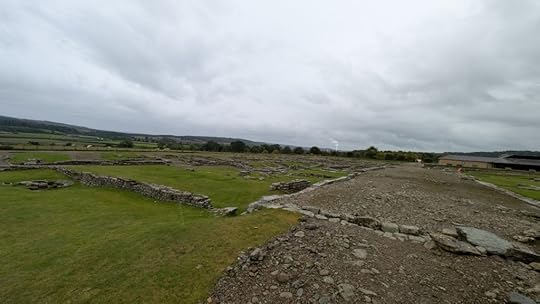 The Bones Of Corbridge
The Bones Of CorbridgeEnglish Heritage have done a bang-up job of contextualising, documenting and humanising the occupier’s presence at Corbridge — they probably called it Corstopitum, or possibly Coria. The excavated remains on view, comprising most of the main drag, and foundations of the granary, central water store and shops, show perhaps a tenth of the true expanse of the place. Let’s be clear, though — Coria was first and foremost a military base. It was an important garrison town, housing hundreds of troops. From here, it was a short trip to the northern boundary of the entire Roman Empire.
Beginning as a fort, by the end of Roman occupancy some time in the third century AD Coria had expanded to include two walled military compounds, sitting comfortably and peacefully alongside a sizable civilian population who provided the infrastructure needed to keep things humming. The détente between the invaders and natives became increasingly cordiale. As seemed common in Roman Britain, many Brits talked, dressed and spoke like their rulers. In some cases, I guess, it makes common sense. What did the Romans ever do for us? Well, underfloor heating would have been welcome in chilly Northumbria for a start.
There would have been generations living and dying in this thriving metropolis who would have known nothing but Roman occupation. To them, perhaps, this was the way it would always be. But Coria was waaay out on the northern edge of an empire which even at the town’s most populous and bustling was already feeling the effects of overextension. It was inevitable things would start to unravel, which they did with terrifying rapidity once the troops withdrew back to warmer climes.
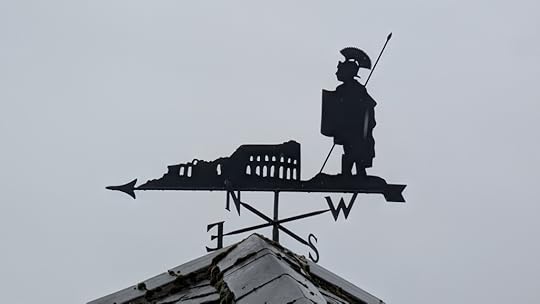 Rome This Way
Rome This WayThe town would remain. I mean, there’s all those retail opportunities to explore once you head back along St. Helen’s Lane, so it’s not like the Danes reduced everything to smoking rubble once they roared in from the North Sea. Another bunch of pesky immigrants landing in small boats — the Anglo Saxons — would have also found the town and its position on major road and river routes a pretty useful place to park up before a light spot of pillaging. Call it Corebricg or Colebruge, the rulers and name of the village have always been somewhat Debatable. But it’s still standing, solid as the Wall it was originally built to support.
A very different version of history education can be found at Beamish, maybe an hour’s drive (or a day’s march if we’re being sticklers about it) south-east of Corbridge. It’s home to the Musuem of Living History, which takes an extremely hands-on approach. Based loosely on Scandinavian ‘open air’ museums, founder Frank Atkinson decided history was best experienced in an immersive fashion.
Over a 300 acre site, Beamish offers visitors the chance to wander at will around a bunch of different settings, all walkable or, in the manner this writer and his wife with the dicky knee recommends, via a charming collection of vintage buses and trams. From an 1820s manor to an early 20th century colliery and pit village to a council estate and high street from the 50s, the time-dilation effect can be a little overwhelming.
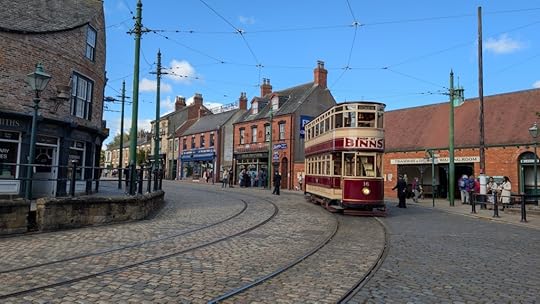 Not a 1910 High Street
Not a 1910 High StreetThere is an exacting sense of detail, helped by Atkinson’s initial call for donations. It was absurdly successful — items from matchbooks to the shops which sold them were offered to the great project. There is a printers at Beamish, a working sweet shop, a beautifully restored cinema and, because we are in the North East after all, two chippies. These are a resounding hit and something of a food destination in themselves. They cook in beef dripping, and you will feel deliciously lubricated after snorting down a portion.
Immersive as Beamish is, I couldn’t help but feel a sense of theme-parkery about the whole exercise. No-one’s asking you to pull out a farthing for your mid-tour cuppa—it’s all, thankfully, contactless. In fact the young chap at the ice-cream stall seemed a little flummoxed when the nice lady in front of us pulled out a twenty to pay for her cones. But everything is clean, well-organised and careful to avoid offence.
Ok, fine, it’s probably best that the endless reek of tobacco smoke and horse dung that would add an acrid tang of realism is absent. And after all, Beamish is supposed to be a nice day out, not a deep dive into child labour, crushing poverty and all the other horrors of working class life over the past two hundred years. A little more context would have been nice, but volunteers are everywhere and they’re all knowledgeable and happy to chat. Again, that’s the immersive nature of the enterprise. If I don’t wanna talk to people, that’s my fault, not theirs.
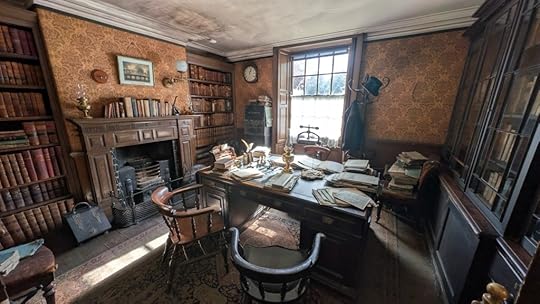
And I’ll admit to a Proustian moment, one I was far from alone in experiencing. The 1950s council estate houses a strip of cottages and two-up-two-downs, furnished in the style of the era. You can tell the donation model Frank Atkinson advocated was a real hit for this post-war period. Every object in those houses has a life and history to it. The detail I mentioned earlier is extraordinarily granular—open a kitchen drawer and it’ll be full of utensils your nan would have used.
There’s a reverence from people as they drift from room to room, people who for the most part were my age or a little older. They knew rooms like this. They may have grown-up somewhere similar. The recognition, the soft hit of memory came to a lot of folks, whether through a particular model of washing machine, the patterned glass front to a cabinet, or perhaps just the way light seems to hover differently in a room warmed by the smoky heat of a coal fire. I’ll be frank. I saw my grandparents in every room, and a small version of myself in some of the bedrooms. I’d have been under the covers, nose in a Beano annual. I walked out of the 1950s zone with a lump in my throat and a hankering for a taste of one of my Nan Bet’s rock cakes.
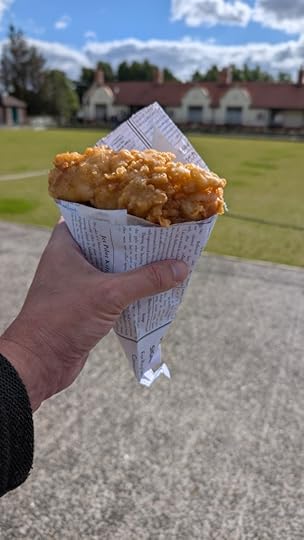 Or, if unavailable, just have another portion of fish and chips.
Or, if unavailable, just have another portion of fish and chips.On the way back to the cottage from Beamish, that nagging feeling returned. The trouble with history is it isn’t fixed. The ‘truth’, or the version of it we are presented with, can change at any time based on the reappraisal of old evidence, or the discovery of new documents which can easily upend the ‘facts.’. It’s a slippery thing, squirming and mutating under our fingers just when we think we have a firm grip on it. The old saying states that history is written by the victors, who want us to believe the story they want to tell. While that used to be a given, when it comes to subjects like slavery, there’s more tan one tale to be told. Marginalised voices are rising, becoming too loud to be ignored. Which doesn’t mean the old order won’t try to reassert their version — look at the ongoing furore from —let’s call them vested interests — at the National Trust’s gentle efforts to remind their visitors that the grand houses they wander through were not funded through entirely philanthropic means.
And of course it’s impossible to properly contextualise the lived experience of the past with our own. How can we begin to understand what the life of a shopkeeper at Coria was really like, or a farm worker at the 1820’s Pockerley Hall at Beamish? What did they hope for, dream of? What did they sound like, or gods help us smell like? The issue for me with places that claim to have an immersive element is they cannot engage all the senses. You can see, hear and, if you grab a portion of fish and chips, taste an approximation of the lives lived in the past. But that’s it. It’s a blunted, incomplete picture.
It’s quite eerie to walk through a carefully-curated farm cottage with the fire lit, pictures on the wall, perhaps even bread on the table, but no people in sight. It’s as if they’ve been lifted up and away, like they don’t matter. It’s coincidence, naturally, that we visited Beamish on a day when certain over-excitable Christian types declared The Rapture was coming, but I couldn’t help but be reminded of it. The people who should have been at the forefront of our attention were not there to tell their stories. All that was left — was us.
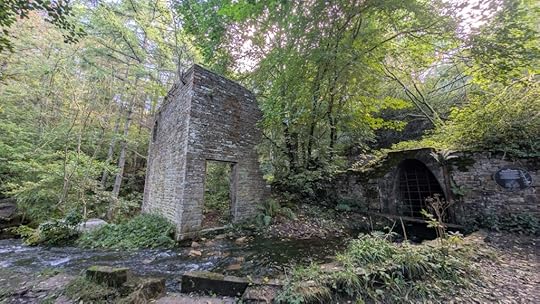 All that remains of The Blackett Level workings at Allendale, an incomplete water course.
All that remains of The Blackett Level workings at Allendale, an incomplete water course.What I’m trying to say — I think — is, when you visit places like Beamish or Corbridge, or any of the museums on Hadrian’s Wall, or any site of historic interest, the onus is on entertainment, not education. You may pick up a few scraps from an information board, or a bloke in a miner’s costume might tell you how the two-check system to ensure workers were fairly paid for the coal they brought up was concieved. But you’re going to have to work a heck of a lot harder if you want a more accurate picture. And the awful truth of it is, even at the highest level, you will run up against the phrase ‘we simply don’t know’ more often than is comfortable.
Memory, too, is a fragile source of documentary evidence. Oral histories of days gone by are often told by those with failing recollections of the times we’re relying so heavily on them to relate accurately. You know, old people. I mean, blimey, I often can’t remember what I had for dinner this time last week. When, at some point in the not-too-distant future, a fresh-faced researcher places a microphone in front of me and asks me to tell them what the 70s and 80s were like — well, they say if you can remember a time, you weren’t really living it. I suspect any observations I have of my youth with will be blurry at best. 1985, a key moment in my formation, was 40 years ago, and I had discovered alcohol.
At the 1950s houses at Beamish, there were school parties wandering about for whom the experience of a smoky parlour or the revelation of a mangle would be as unknowable as the foundations at Corbridge. The tiny TVs and lack of microwaves would be simply bewildering, apparitions from a ghost town. There’s no connection for them. The people who would be able to tell them what it was like are disappearing with every year that passes, and would probably make things up anyway.
I sound very bleak about the whole experience, and I shouldn’t. C and I had a great time in Northumberland. Corbridge and Beamish were highlights, especially as they proved to be more thought provoking than expected. You should definitely go, and have a think about how we see the past from our present.
I wonder how, in another thirty or forty years, I will remember this last week up in the border territories. What details will stay fresh, and which will fade or change or simply vanish, like smoke up a chimney, like the taste of beef fat on my lips? That, like so much up here, remains Debatable.
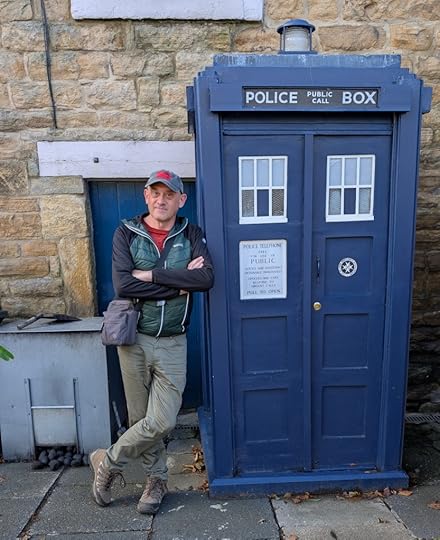 A time traveller, yesterday.
A time traveller, yesterday.The Beamish Museum Of Living History is open all year and despite all my snarking is a grand day out.
Corbridge Roman Town is a ten-minute walk from the centre of town and has an extremely good museum attached. The audio tour which comes with admission is extremely useful.
While in the area, we don’t think you’ll go wrong with beer from Allendale Brew Co (the Lion House on the main square does a cracking Sunday roast which goes perfectly with a pint of Pennine Pale, and while you’re there please support the Museum of Classic Sci-Fi — just look for the Tardis and the famous Allendalek). We also strongly recommend Twice Brewed, who are multiple award winners for their beers, have a well-deserved rep for their food and do a fetching line in metal-inspired t-shirts.
See you next Saturday, chrononauts.



